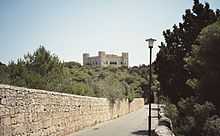Buskett Gardens

The Buskett Gardens, forming one of the few woodland areas in Malta, are located in the fertile valley of Wied Il- Luq in Siggiewi. The 30 ha site lies to the west of Siggiewi (Citta Ferdinand) and just east of Dingli. The Verdala Palace, an official residence of the President of Malta, stands on the edge of the Gardens.
History
Indigenous forests once covered Malta, but trees were cut down for shipbuilding in the era when galleons plied the Mediterranean waters and for agricultural purposes. The gardens were planted by the Knights Hospitaller as a hunting reserve.
Description
The gardens contain broadleaved deciduous woodland, native coniferous woodland, with sclerophyllous garrigue and maquis shrubland, as well as groves of fruit trees.[1]
Usage
Many different trees and shrubs grow in the gardens, including numerous fruit-bearing trees. One of the greenest areas in Malta, the gardens are at their best in the spring but also provide shade from the harsh mid-summer sun and offer a quiet place for a walk in the winter months. The gardens are very popular with the Maltese people, who often go for walks in the peaceful settings or enjoy a picnic in the shade of the trees. The gardens serve as a venue for the Feast of Imnarja which is celebrated on 29 June. Hundreds of people flock there the previous evening, to eat the traditional Maltese dish of rabbit stew cooked in wine, to listen to traditional folk music and singing, and to enjoy the annual agricultural show in the morning.
Verdala Palace

The Verdala Palace is perched on a hilltop adjoining and overlooking Buskett Gardens. It was built by Grand Master Hughes de Verdalle in 1588 as a summer residence. Following restoration, this elegant building now serves as the President's summer residence. The palace is not open to the public, but it does offer a notable landmark visible clearly from Dingli Cliffs, towering as it does over the Buskett woodland.
Important Bird Area
The gardens have been identified as an Important Bird Area (IBA) by BirdLife International because they support large numbers of birds, especially as a sanctuary to those on seasonal migration through the Maltese Archipelago.[1]
References
- ↑ 1.0 1.1 "Buskett and Wied il-Luq". Important Bird Areas factsheet. BirdLife International. 2013. Retrieved 2013-08-05.
External links